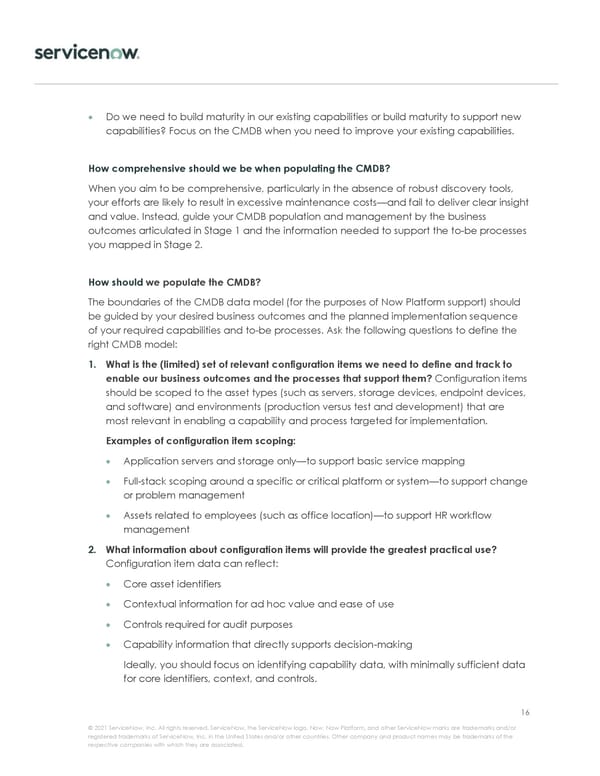• Do we need to build maturity in our existing capabilities or build maturity to support new capabilities? Focus on the CMDB when you need to improve your existing capabilities. How comprehensive should we be when populating the CMDB? When you aim to be comprehensive, particularly in the absence of robust discovery tools, your efforts are likely to result in excessive maintenance costs4and fail to deliver clear insight and value. Instead, guide your CMDB population and management by the business outcomes articulated in Stage 1 and the information needed to support the to-be processes you mapped in Stage 2. How should we populate the CMDB? The boundaries of the CMDB data model (for the purposes of Now Platform support) should be guided by your desired business outcomes and the planned implementation sequence of your required capabilities and to-be processes. Ask the following questions to define the right CMDB model: 1. What is the (limited) set of relevant configuration items we need to define and track to enable our business outcomes and the processes that support them? Configuration items should be scoped to the asset types (such as servers, storage devices, endpoint devices, and software) and environments (production versus test and development) that are most relevant in enabling a capability and process targeted for implementation. Examples of configuration item scoping: • Application servers and storage only4to support basic service mapping • Full-stack scoping around a specific or critical platform or system4to support change or problem management • Assets related to employees (such as office location)4to support HR workflow management 2. What information about configuration items will provide the greatest practical use? Configuration item data can reflect: • Core asset identifiers • Contextual information for ad hoc value and ease of use • Controls required for audit purposes • Capability information that directly supports decision-making Ideally, you should focus on identifying capability data, with minimally sufficient data for core identifiers, context, and controls. 16 © 2021 ServiceNow, Inc. All rights reserved. ServiceNow, the ServiceNow logo, Now, Now Platform, and other ServiceNow marks are trademarks and/or registered trademarks of ServiceNow, Inc. in the United States and/or other countries. Other company and product names may be trademarks of the respective companies with which they are associated.
 Implementation Journey Page 15 Page 17
Implementation Journey Page 15 Page 17